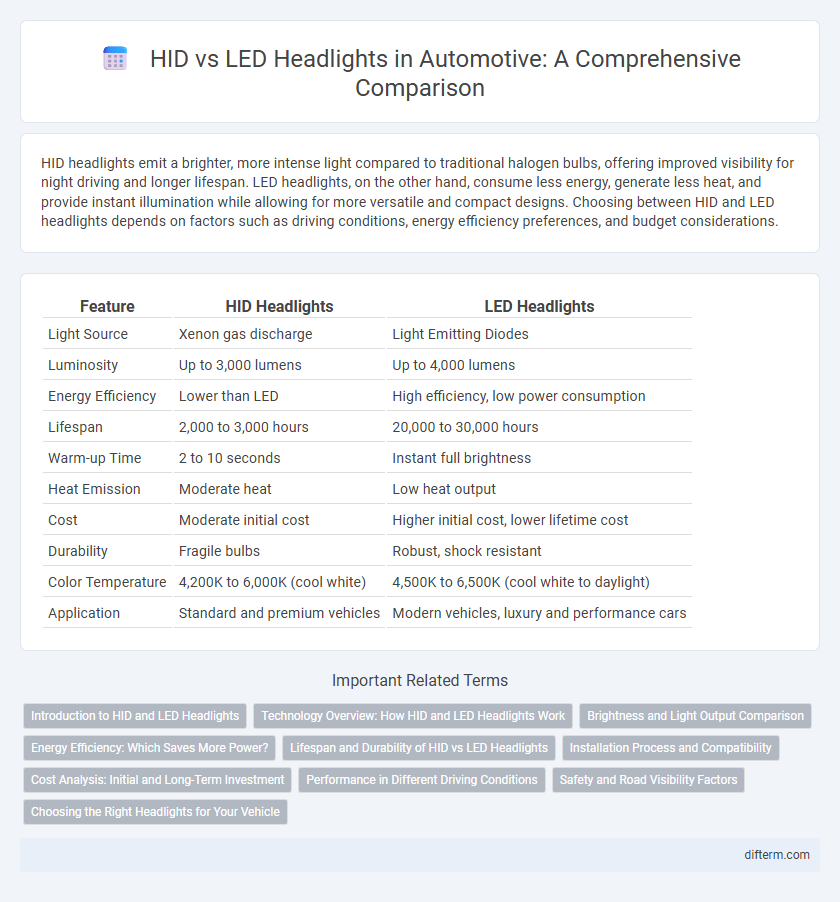HID headlights emit a brighter, more intense light compared to traditional halogen bulbs, offering improved visibility for night driving and longer lifespan. LED headlights, on the other hand, consume less energy, generate less heat, and provide instant illumination while allowing for more versatile and compact designs. Choosing between HID and LED headlights depends on factors such as driving conditions, energy efficiency preferences, and budget considerations.
Table of Comparison
| Feature | HID Headlights | LED Headlights |
|---|---|---|
| Light Source | Xenon gas discharge | Light Emitting Diodes |
| Luminosity | Up to 3,000 lumens | Up to 4,000 lumens |
| Energy Efficiency | Lower than LED | High efficiency, low power consumption |
| Lifespan | 2,000 to 3,000 hours | 20,000 to 30,000 hours |
| Warm-up Time | 2 to 10 seconds | Instant full brightness |
| Heat Emission | Moderate heat | Low heat output |
| Cost | Moderate initial cost | Higher initial cost, lower lifetime cost |
| Durability | Fragile bulbs | Robust, shock resistant |
| Color Temperature | 4,200K to 6,000K (cool white) | 4,500K to 6,500K (cool white to daylight) |
| Application | Standard and premium vehicles | Modern vehicles, luxury and performance cars |
Introduction to HID and LED Headlights
HID headlights use xenon gas to produce bright, intense light with high color temperature, offering superior visibility compared to traditional halogen bulbs. LED headlights utilize semiconductor technology to emit light efficiently, providing longer lifespan and lower energy consumption while maintaining sharp illumination. Both technologies enhance automotive lighting performance but differ significantly in design, energy use, and durability.
Technology Overview: How HID and LED Headlights Work
HID headlights utilize xenon gas and electric arc technology to produce bright, intense light by ionizing gas between electrodes, offering high visibility and longer range. LED headlights operate by passing electrical current through semiconductor chips that emit light efficiently and with lower energy consumption. Both systems enhance night driving safety but differ significantly in energy efficiency, heat production, and lifespan due to their distinct technological mechanisms.
Brightness and Light Output Comparison
HID headlights produce a brighter and more intense light output compared to LED headlights, typically ranging from 3,000 to 3,500 lumens versus 2,000 to 3,000 lumens for LEDs. The color temperature of HID lights usually falls between 4,300K and 6,000K, delivering a whiter or bluish beam that enhances visibility on the road. Conversely, LED headlights offer a more focused and uniform light distribution with faster response times, but generally do not surpass HID brightness levels in raw lumens.
Energy Efficiency: Which Saves More Power?
LED headlights consume significantly less power than HID headlights, typically using around 15-45 watts compared to HID's 35-85 watts, making LEDs more energy-efficient. LED technology converts a higher percentage of electrical energy into light, resulting in reduced energy loss as heat. This efficiency not only extends vehicle battery life but also decreases fuel consumption in traditional cars due to lower electrical demand.
Lifespan and Durability of HID vs LED Headlights
LED headlights offer a significantly longer lifespan, typically lasting up to 25,000 hours, compared to HID headlights which average around 2,000 to 3,000 hours. LED bulbs are more durable due to their solid-state construction, making them resistant to vibrations and impacts common in automotive environments. HID headlights, while brighter initially, tend to degrade faster and are more susceptible to damage from frequent on/off cycling.
Installation Process and Compatibility
HID headlights require a ballast for operation, making the installation process more complex and time-consuming compared to LED headlights, which often feature plug-and-play designs for easier upgrades. Compatibility with vehicle electrical systems varies; HID systems may need modifications to the wiring harness or headlight housing due to their higher voltage requirements. LED headlights generally offer better compatibility with modern vehicles, minimizing installation challenges and reducing the risk of electrical issues.
Cost Analysis: Initial and Long-Term Investment
HID headlights typically have a higher initial cost, ranging from $100 to $200 per unit, while LED headlights can cost between $150 and $300 due to advanced technology and longer lifespan. Over the long term, LED headlights offer better energy efficiency and durability, reducing replacement and maintenance expenses, resulting in a lower total cost of ownership. Cost analysis reveals that despite higher upfront costs, LED headlights provide significant savings over HID headlights through extended operational life and decreased power consumption.
Performance in Different Driving Conditions
HID headlights provide intense, bright light with excellent long-distance visibility, making them ideal for highway and rural driving where seeing far ahead is crucial. LED headlights offer superior performance in various weather conditions, including fog and rain, due to their instant illumination and consistent brightness. Both types deliver high energy efficiency, but LEDs maintain better durability and color temperature stability across diverse environments.
Safety and Road Visibility Factors
HID headlights produce a brighter and more intense light output compared to traditional halogen bulbs, enhancing road visibility by illuminating a wider area and improving reaction times to obstacles or hazards. LED headlights offer sharper, more focused beams with faster activation and longer lifespan, contributing to consistent road illumination and reduced glare for oncoming drivers. Both technologies significantly improve nighttime driving safety by increasing contrast and reducing eye strain, but LED headlights provide superior energy efficiency and durability under varying weather conditions.
Choosing the Right Headlights for Your Vehicle
HID headlights deliver intense, bright light improving night visibility with a longer range, ideal for highway driving, while LED headlights offer energy efficiency, longevity, and faster illumination suitable for various driving conditions. Vehicle compatibility and local regulations should guide your choice, as some cars require specific headlight systems for optimal performance and legal compliance. Prioritizing factors like brightness, lifespan, energy consumption, and installation complexity ensures selecting the right headlights enhances safety and driving experience.
HID headlights vs LED headlights Infographic

 difterm.com
difterm.com